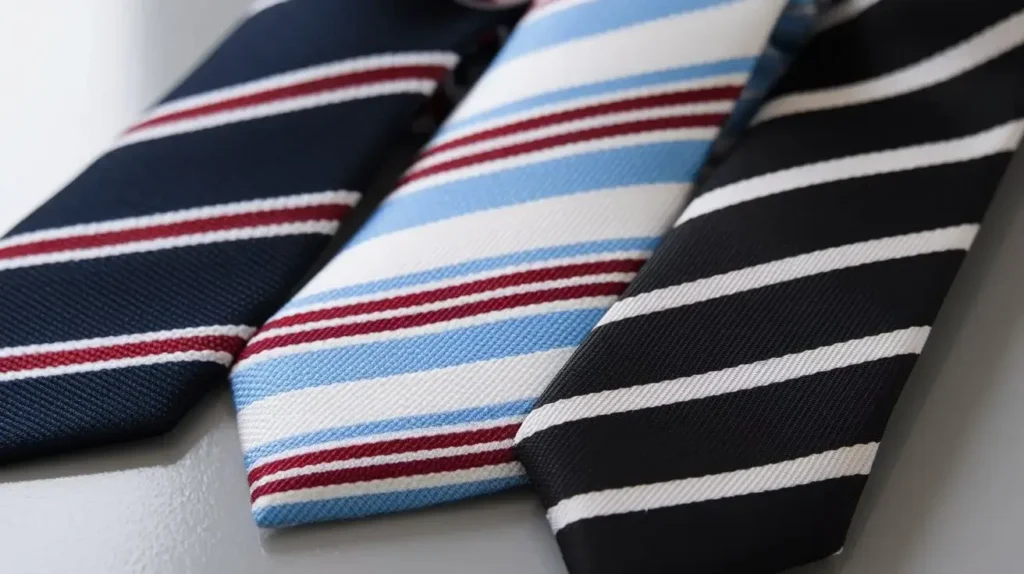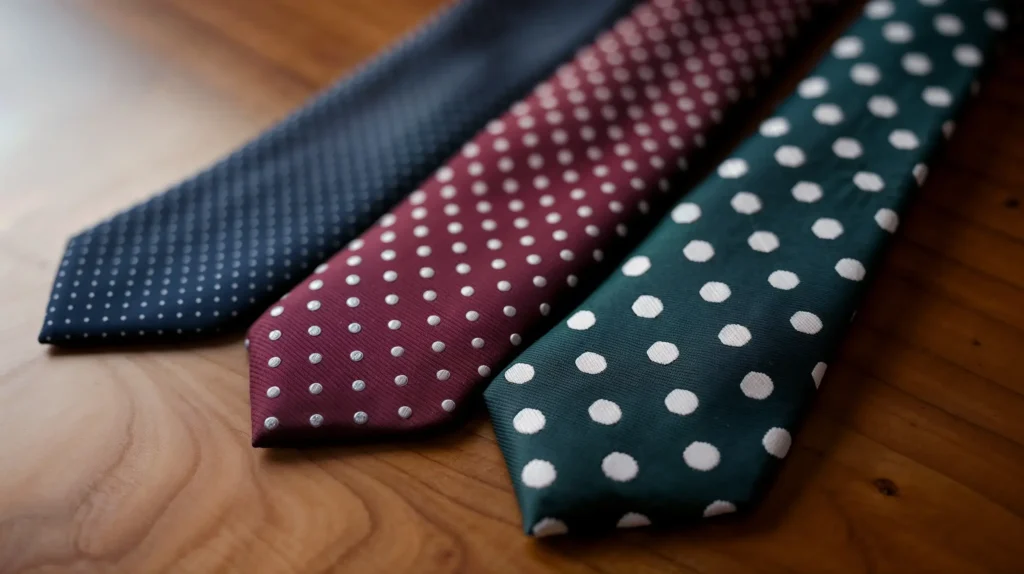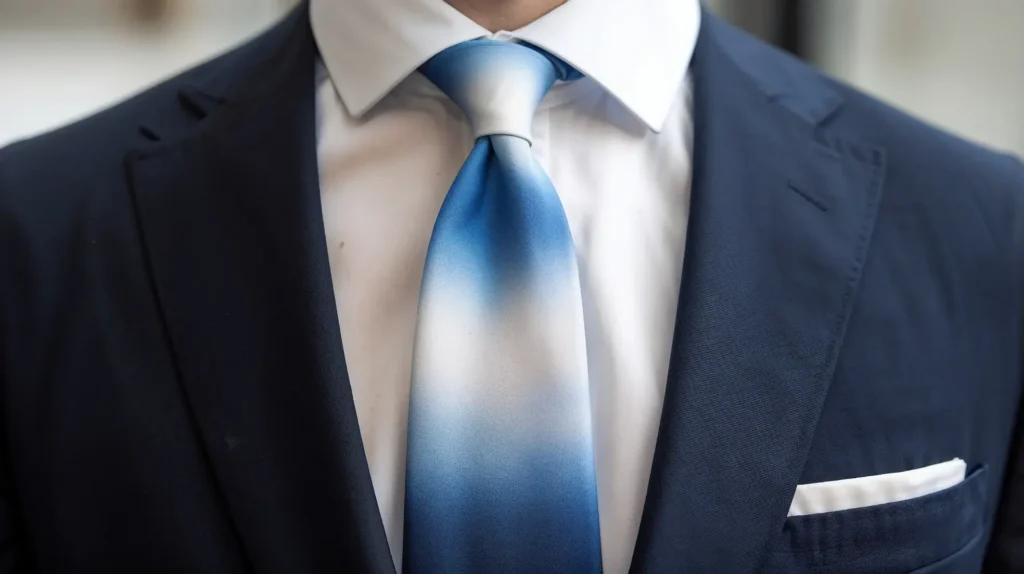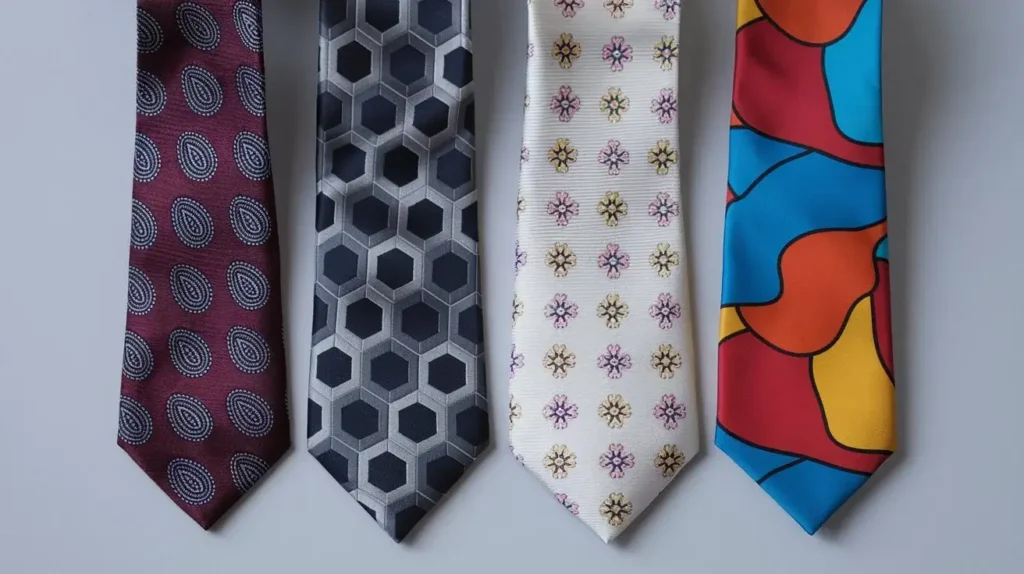Tie Patterns: A Guide to Stripes, Polka Dots, and More
Choosing a tie isn’t just about matching colors—patterns play a key role in shaping your overall look. Whether you’re heading to a meeting or a wedding, or just want to add a touch of style to your day, understanding tie patterns is essential.
This guide will break down popular tie patterns, offering practical tips on when and where each works best. By the end, you’ll be confident to pick patterns that suit your style and occasion. So, without further ado, let’s get started.
Contents
1. The Classic Stripes: A Timeless Choice
Stripes are the workhorses of the tie world. They’re versatile, and professional, and come in endless variations. But not all stripes are created equal.

Types of Striped Ties
- Repp Stripes: These diagonal stripes originated in British regimental ties. They’re a go-to for a polished, traditional look.
- Pin Stripes: Thin, widely spaced stripes that offer a subtle pattern. Great for those new to patterns.
- Awning Stripes: Wide, bold stripes that make a statement. Use these when you want to stand out.
- Candy Stripes: Typically featuring white alternating with color, these have a fresh, slightly casual vibe.
When to Wear Striped Ties
Striped ties are incredibly versatile. They work well in most professional settings and can easily transition to after-work events. For conservative offices, stick to darker colors with subtle stripes. Bolder stripes in brighter colors are perfect for creative workplaces or social occasions.
Pairing Striped Ties
The key is to vary the scale of patterns. If your shirt has a small check, go for a tie with wider stripes. With a solid shirt, you have more freedom – experiment with different stripe widths and colors.
Pro Tip: A navy tie with thin white stripes is a wardrobe essential. It pairs well with nearly any shirt and suit combination.
Recommended Picks
- Brooks Brothers Striped Tie – A multi-colored that never goes out of style.
- Tommy Hilfiger Solid textured stripe Tie – Great quality at a reasonable price point.
2. Polka Dots: From Playful to Professional
Don’t let the playful name fool you – polka dot ties can be surprisingly versatile. The key is in the size and spacing of the dots.
Dot Sizes and Spacing

- Micro Dots: Tiny, closely spaced dots create a texture from afar. These are great for a subtle pattern in formal settings.
- Medium Dots: The most versatile size. They’re noticeable without being overwhelming.
- Large Dots: Make a bold statement. Best reserved for creative or casual environments.
Color Combinations
Traditional combinations like navy with white dots or burgundy with silver dots are foolproof choices for the office. For a more daring look, try unexpected color pairings like green with pink dots or purple with yellow dots.
When to Wear Polka Dots
Polka dot ties work well in a variety of settings:
- Small, widely spaced dots in muted colors are perfect for conservative offices.
- Medium-sized dots in bolder colors are great for creative workplaces or social events.
- Large, colorful dots can add a touch of whimsy to a casual outfit.
Pro Tip: When wearing a polka dot tie, keep the rest of your outfit simple. Let the tie be the star of the show.
Recommended Picks
- Stacy Adams Dots Tie – Offers a great balance of style and affordability.
- OTAA Dot Tie – A high-end option for those looking to invest in quality.
3. Tie-Dye: Not Just for Hippies Anymore
Forget what you think you know about tie-dye. Modern tie-dye ties are a far cry from the psychedelic shirts of the ’60s. They offer a unique way to add texture and color to your outfit.

Modern Tie-Dye Patterns
- Subtle Ombré: A gradual color transition that adds depth without overwhelming.
- Watercolor Effect: Soft, blended colors that create an artistic look.
- Geometric Tie-Dye: Structured patterns that offer a more controlled take on the tie-dye trend.
Pulling Off a Tie-Dye Tie
The key is balance. Pair a tie-dye tie with solid, neutral pieces to let it shine. A light blue tie-dye tie can look surprisingly sophisticated with a white shirt and navy suit.
For the Office
Yes, you can wear tie-dye to work! Look for ties with subtle patterns in muted colors. A tie with gentle gradients of blue or gray can add interest to your outfit without raising eyebrows.
Pro Tip: If you’re new to tie-dye ties, start with monochromatic designs. They’re easier to incorporate into your existing wardrobe.
Other Popular Patterns
While stripes, polka dots, and tie-dye are having their moment, don’t overlook these other classic patterns:

1. Paisley
This teardrop-shaped pattern has roots in Persian design. It’s perfect for adding a touch of sophistication to your look. Pair a burgundy paisley tie with a light blue shirt for a classic combination.
2. Geometric
From simple repeating shapes to complex tessellations, geometric patterns offer a modern, stylish option. They’re great for tech or creative industries where you can push the envelope a bit.
3. Floral
No longer just for spring, floral ties are making a comeback. Look for small, repeating patterns for a subtle nod to nature, or go bold with large, colorful blooms for a statement piece.
4. Abstract
These ties feature non-representational designs, often with bold colors and shapes. They’re perfect for adding an artistic touch to your outfit.
Pro Tip: When wearing a boldly patterned tie, keep the rest of your outfit simple. Let the tie be the focal point.
Recommended Picks
- Jacob Alexander Floral Tie – A classic floral pattern in a modern color palette.
- Barry.Wang Classic Tie – Sleek, modern geometric patterns at a mid-range price point.
Pattern Mixing: Advanced Tie Game
Ready to level up your tie game? Pattern mixing is an art, but with a few simple rules, you can master it:
- Vary the scale: If your shirt has a small check, your tie should have a larger pattern.
- Stick to a color family: Keep your patterns in the same color family for a cohesive look.
- Include a solid: If you’re mixing patterns in your shirt and tie, keep your suit solid.
- Use odd numbers: The rule of three applies here. If you’re feeling bold, try mixing three patterns (e.g., striped suit, checked shirt, paisley tie).
Example Combinations
- Gingham check shirt + floral tie + solid suit
- Striped shirt + polka dot tie + textured solid suit
- Solid shirt + paisley tie + pinstripe suit
Pro Tip: Start with subtle pattern mixing and gradually work your way up to bolder combinations as you gain confidence.
Frequently Asked Questions
Q: Can I wear a patterned tie with a patterned shirt?
A: Yes, but follow the rule of varying scales. If your shirt has a small pattern, choose a tie with a larger pattern, and vice versa.
Q: Can I wear a patterned tie to a job interview?
A: It depends on the industry. For conservative fields like finance or law, stick to subtle patterns like pinstripes or small polka dots. For creative fields, you have more leeway to express yourself with bolder patterns.
Q: Can I wear a patterned tie to a wedding?
A: Absolutely! For daytime or casual weddings, you can be more adventurous with patterns. For formal evening weddings, stick to subtle patterns in classic colors like navy or burgundy.
Q: How do I match a patterned tie with a pocket square?
A: They shouldn’t match exactly, but should complement each other. If your tie has multiple colors, pick out a secondary color for your pocket square. Alternatively, if your tie has a bold pattern, opt for a solid pocket square in a complementary color.
Q: Are there any patterns I should avoid for business settings?
A: Generally, very large patterns, overly bright colors, or novelty prints (like cartoon characters) are best avoided in conservative business environments. Stick to classic patterns like stripes, small polka dots, or subtle paisleys.